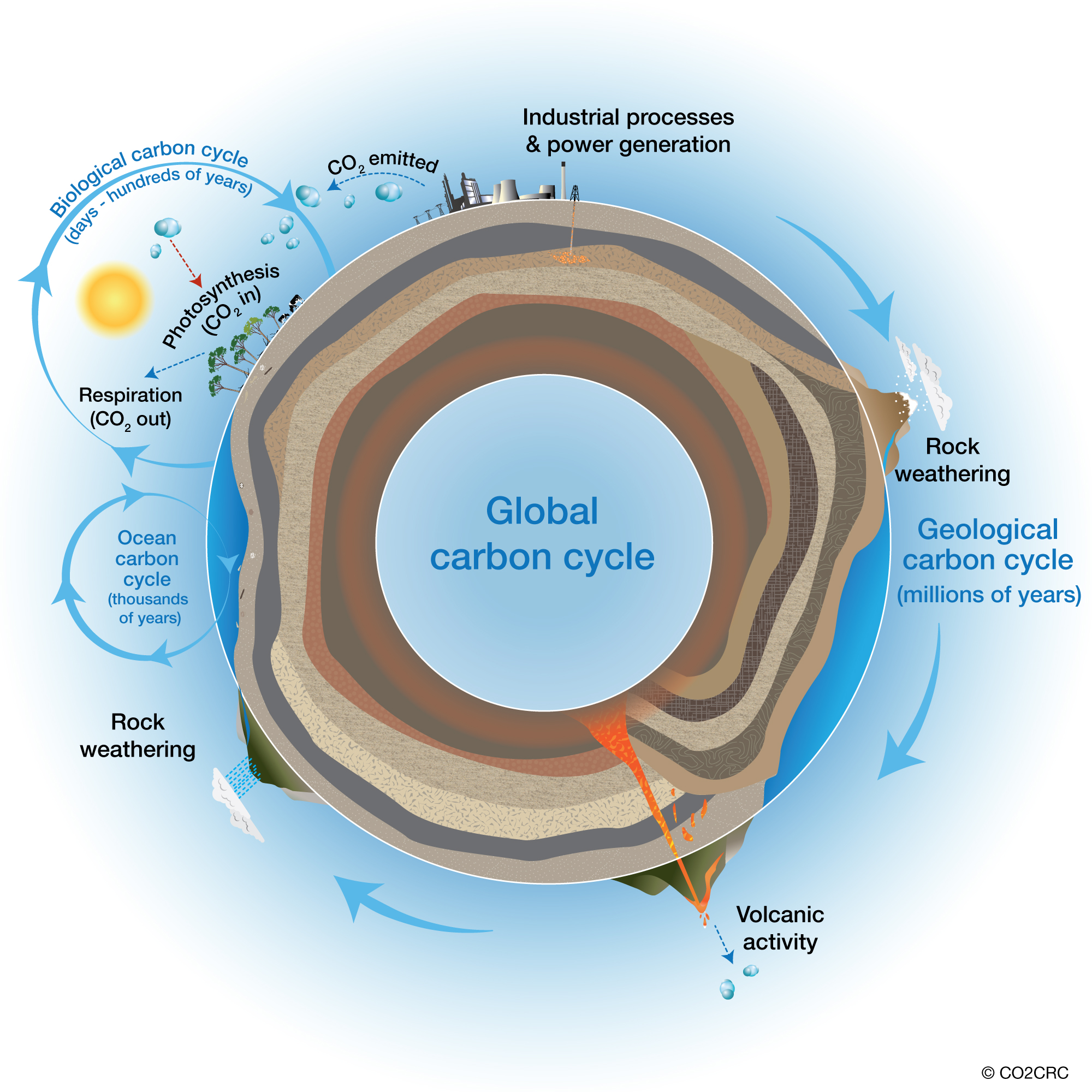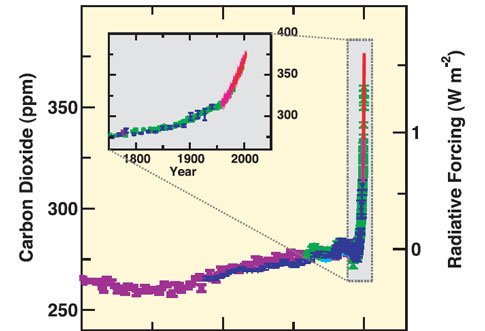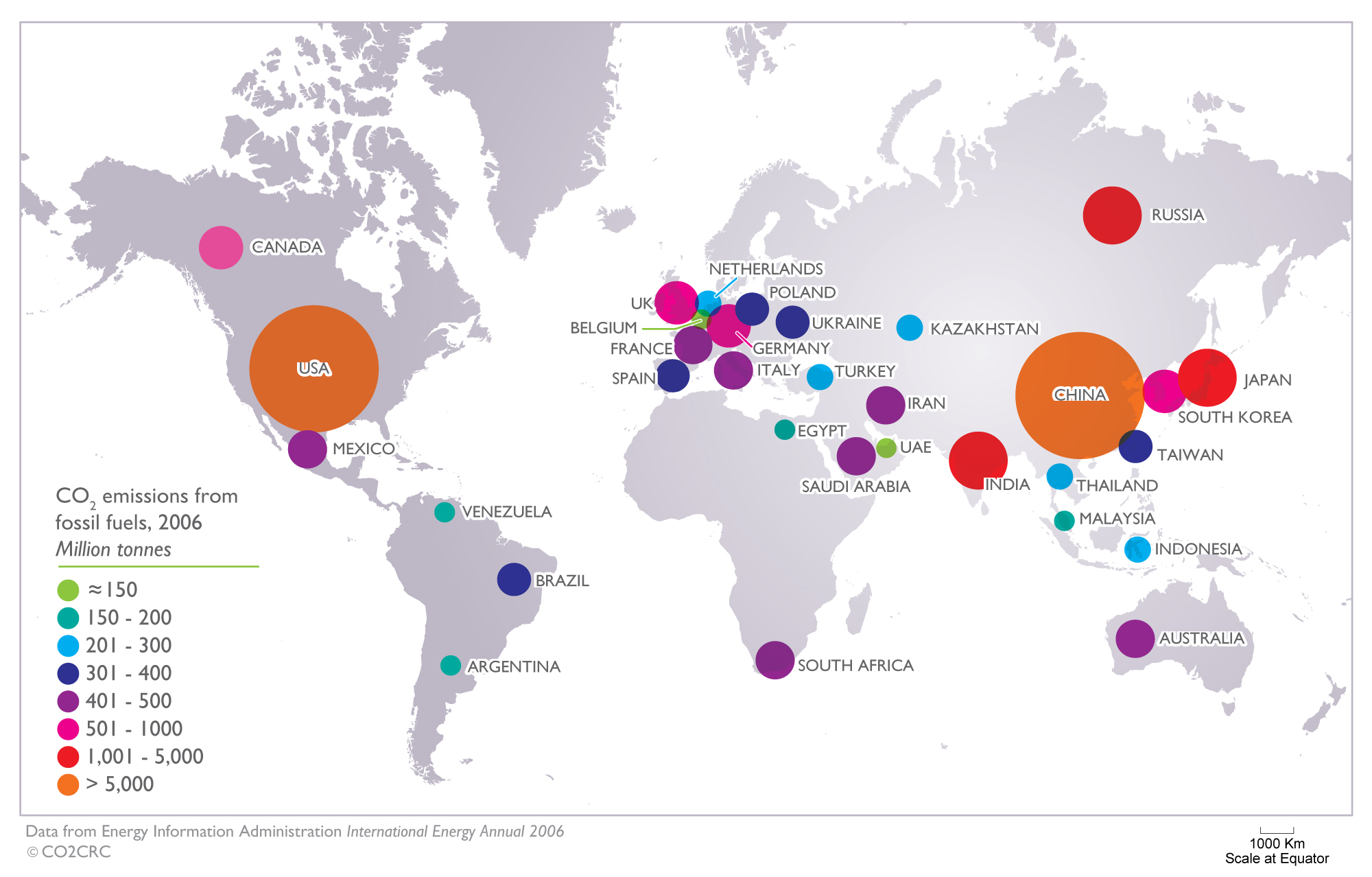> CO2 and Climate Change
Climate change
Global climate is being changed by increases in concentrations of greenhouse gases in the atmosphere.
Predicted changes include higher average temperatures; more-frequent heat-waves; a higher proportion of rainfall coming from very heavy rain, increases in the area affected by droughts, more-intense tropical cyclones, and rising sea levels.
Some changes have already occurred: 11 of the 12 years from 1995 to 2006 were among the 12 warmest years on record (since 1850); the rate of warming is increasing, with the warming trend over the past 50 years (0.13°C per decade) almost twice the rate of the past 100 years; both expansion of water in the oceans because of warming to depths of at least 3,000 metres and widespread melting of glaciers, ice caps, and the ice sheets of Greenland and Antarctica caused sea levels to rise at the rate of about 3.1 millimetres a year in the decade to 2003; rainfall and wind patterns have changed; and droughts have become both more intense and longer.

The increased concentrations of greenhouse gases in the atmosphere are caused by the activities of our industrialised society, mainly the burning of fossil fuels to generate electricity to power factories, commercial buildings and homes, and in transport, but also in industry and through agricultural practices and land clearing.
The greenhouse gases people cause to be emitted to the atmosphere include carbon dioxide, methane, nitrous oxide, perfluorocarbons, hydroflurocarbons, and sulphur hexaflouride.
Carbon dioxide, though, is by far the most important, and both the extent of emissions and the concentration of carbon dioxide in the atmosphere are growing rapidly. The global atmospheric concentration of carbon dioxide has increased from a pre-industrial level of about 280 parts per million to about 380 parts per million now. The major cause of carbon dioxide emissions to the atmosphere is combustion of fossil fuels such as coal, oil and gas, with land-clearing a secondary cause. Global carbon dioxide emissions from fossil-fuel use alone are estimated to have increased from 23.5 billion tonnes a year in the 1990s to 26.4 billion tonnes a year in 2000 to 2005. The annual increase in carbon dioxide emissions from burning fossil fuels and industrial processes rose from an average of 1.1 per cent a year in the 1990s to more than 3 per cent a year from 2000-2004. Annual carbon dioxide emissions from developed countries increased by 10.3 per cent between 1990 and 2004. While the 80 per cent of world population in developing and the least-developed countries accounted for 73 per cent of the global growth in emissions of carbon dioxide from fossil fuel combustion and industrial processes in 2004, they still produced only 41 per cent of global emissions in that year and have produced only 23 per cent of cumulative carbon dioxide emissions in the past 150 years.
The radiative forcing of carbon dioxide in the atmosphere – its impact on global warming – increased by 20 per cent from 1995 to 2005, the largest change for any decade in at least the past 200 years. Although both methane and nitrous oxide are more powerful greenhouse gases than carbon dioxide, the quantity of carbon dioxide emitted is so much greater than that of other greenhouse gases that the radiative forcing of carbon dioxide in the atmosphere is three times that of methane, and ten times that of nitrous oxide.

Atmospheric concentration of carbon dioxide over the past 10,000 years (large panel) and since 1750 (inset panel). Measurements are shown from ice cores (symbols with different colours for different studies) and atmospheric samples (red lines). The corresponding radiative forcings are shown on the right hand axis of the large panels. From Climate Change 2007: The Physical Science Basis – Summary for Policymakers, February 2007, Intergovernmental Panel on Climate Change

Carbon dioxide emissions from fossil fuel use by country. Data from International Energy Annual 2006, Energy Information Administration.
In the United States, one of the largest emitters of greenhouse gases in the world, carbon dioxide emissions from burning fossil fuel accounted for 80 per cent of the global warming potential of all US greenhouse gases emitted in 2003 and 2004, up from 77 per cent in 1990. US carbon dioxide emissions increased by 20 per cent between 1990 and 2004.
Carbon dioxide is also the most important greenhouse gas emitted by Australia. In terms of their global warming potential – their impact on climate change – carbon dioxide made up 73.5 per cent of emissions of all greenhouse gases caused by peoples’ activities in Australia in 2004. Australian emissions of carbon dioxide are also growing steeply. The energy sector is both the fastest growing source of Australian greenhouse gas emissions and the major source of its emissions of carbon dioxide. Emissions from production of energy in Australia grew 34.7 per cent between 1990 and 2004, when they accounted for more than 86 per cent of Australia’s carbon dioxide emissions.
Source: Cooperative Research Centre for Greenhouse Gas Technologies (CO2CRC) in Australian
<< Previous page
---
Next page >>
TOP
|





